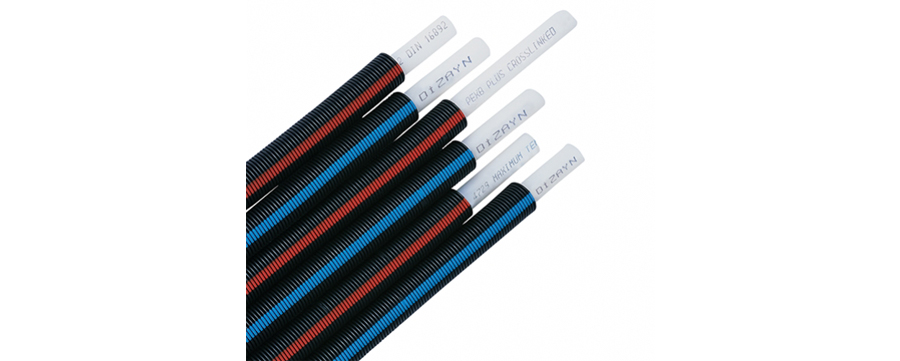GENERAL FEATURES
Polyethylene crosslink (PEX) pipes can be used in hot water and cold water lines. Made of polyethylene raw material, pipes do not resist hot fluids with their normal structures. When the chain structures are transformed into crosslink structures, they gain very high temperature resistance properties. Their structures are transformed from a reusable thermoplastic structure to a non-recyclable thermoset structure.
There are four types of PEX pipes. Those obtained by PEX-a peroxide method, PEX-b Silane method, PEX-c Irradiation method and PEX-d nitrogen method. The difference between these types is only; It is the crosslink rate requested by the standard. Mechanically, these differences have been determined to provide the same strength.
PEX-a is the first production method and a difficult process. It is not preferred for new investments.
PEX-b is the silane method. Agent molecules between chains are placed and these agents make carbon bonds with different chains in steam cure application. It is the most preferred method as the process is completed within the company with all its stages. It continues to be crosslink during use in hot water lines.
PEX-c is the irradiation method. Hydrogen atoms are detached from carbon atoms with rays and as a result of bonding with hydrogen in the other chain, the chains are cross-linked to each other. Since the irradiation processes are located elsewhere outside of production, transportation costs add to the extra product price. There are two different irradiation methods, gamma ray and electron bombardment. If the irradiation dose is not adjusted well, the chains can be damaged. The product discolors and hardens. As the gamma ray kills bacteria, the product is sterilized. Thanks to this feature, it is also preferred in sanitary lines.
PEX-d is obtained by nitrogen method. It is not available in the market as it cannot be superior in terms of competition.
With the thermosetting of PEX pipes, their welding ability disappears. Metal connection elements are used for joining. Metal fasteners are ring union type that does not require additional equipment. While the sleeve is tightened with a wrench, the conical structure of the ring, which is inserted outside the pipe, compresses the pipe and provides sealing. Europe also uses the ring system. Electrical crimping tool investment is required for this method. However, it does not have an advantage over the record system.
PRODUCTION FEATURES
PEX pipes are produced in extruder production lines. The products are packaged in 160 m coils. PEX-b type coils are placed in steam tanks and a 10-hour cure is applied. 65% crosslink value is reached in chain structures. The product reaching this value is shipped. Metal fittings are designed within the company and produced in the sub-industry.
ADVANTAGES
- Dizayn PEX-B Plus Pipe can be used at 95 ° C at PN10 bar.
- It shows resistance when the temperatures rise up to 120 ° C momentarily.
- It can be used in underfloor heating system.
- It is used in radiator connection in mobile installations.
- The oxygen barrier can be covered and prevents the oxygen in the air from passing through the pipe to the water.
- Dizayn PEX-B Plus Pipe shows high resistance to chemicals.
- Since its density is 0.956 gr / cm3, it is light.
- It can be easily assembled with the records without the need for tools
- Since it is 160 m coils, it can be laid in a short time and without wastage.
- No corrosion.
- Dizayn PEX-B Plus Pipe does not react with minerals and its diameter does not narrow.







